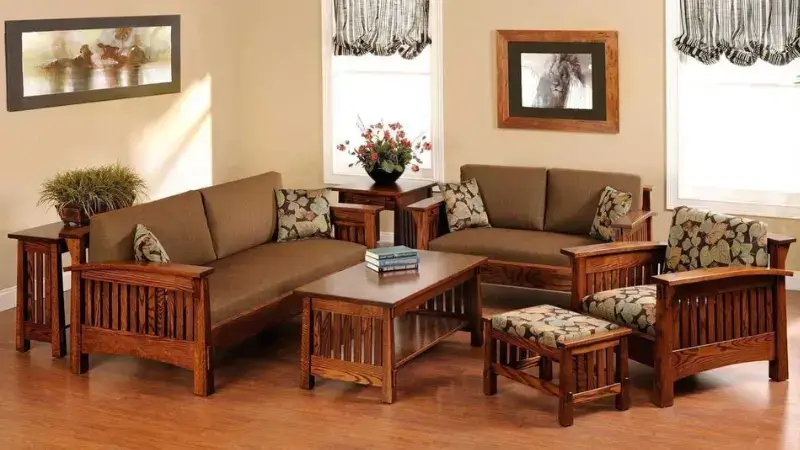
5 Tips to Maintain Wooden Furniture for Years
Wooden furniture is a timeless investment that brings warmth, character,
and elegance into any home. Whether it's a handcrafted dining table, a vintage chest of drawers, or
a simple coffee table, wood adds a natural, organic feel that can’t be replicated by other
materials. However, unlike synthetic furniture, wood is a living material that responds to its
environment. Without proper care and attention, it can lose its luster, crack, warp, or become
discolored over time. With a few simple habits and maintenance tips, you can ensure your cherished
wooden pieces not only last for years but continue to look beautiful for generations to come. This
is especially true for items bought at a best furniture store near me.
1. Control Humidity and Temperature
One of the biggest threats to wooden furniture is a fluctuating
environment. Wood is a hygroscopic material, meaning it absorbs and releases moisture based on the
humidity in the air.
- What: When the
air is too dry, wood loses moisture and can shrink, leading to cracks, splits, and loose
joints. Conversely, when the air is too humid, the wood swells, which can cause it to warp
and buckle.
- Why: Maintaining
a stable humidity level, ideally between 40% and 60%, is crucial for preserving the
structural integrity of your furniture. Extreme temperature changes can also stress the wood
and its finish. This is an important consideration when buying a wooden bed
manufacturer in Indore product.
- How: Use a
humidifier in the dry, winter months and a dehumidifier or air conditioning in the humid,
summer months. Avoid placing wooden furniture near heat sources like fireplaces, radiators,
or air vents, as these can cause the wood to dry out quickly.
- When: Monitor
the humidity in your home throughout the year and adjust your methods as the seasons
change.
2. Protect from Direct Sunlight and Heat
The sun's UV rays are as damaging to wood as they are to human skin.
Prolonged exposure can fade the finish and cause the wood to dry out, leading to cracking and
discoloration.
- What: This tip
is about protecting your furniture from the sun's harsh rays and direct heat sources.
- Why: UV light
can permanently alter the color of the wood, causing dark woods to lighten and lighter woods
to yellow. It also degrades the finish, leaving the wood unprotected.
- How: Arrange
your furniture in a way that avoids direct, prolonged sunlight. Use curtains, blinds, or
window films to filter the light. For pieces near a window, consider rotating them
periodically to ensure even sun exposure. Always use coasters and placemats to protect
surfaces from hot mugs, dishes, and spills.
- When: This is an
ongoing practice. Be mindful of the sun's path throughout the day and the changing
seasons.
3. Dust and Clean Regularly
Regular cleaning is the most basic, yet most effective, form of
maintenance. Dust, when left to accumulate, can be abrasive and cause tiny scratches on the surface
of your furniture, dulling its shine over time.
- What: This
involves a two-part approach: regular dusting and occasional, gentle cleaning.
- Why: Frequent
dusting prevents the buildup of abrasive particles that can scratch the finish. For more
stubborn grime, a light cleaning is necessary to restore the wood's natural glow.
- How: Use a soft,
lint-free microfiber cloth to dust weekly. For a deeper clean, lightly dampen a cloth with a
mild soap and water solution, wipe the surface, and immediately dry it with another soft,
clean cloth. Always wipe in the direction of the wood grain to avoid streaks and preserve
the texture.
- When: Dusting
should be a weekly routine, while a deeper clean can be done monthly or as needed.
4. Polish and Wax Periodically
Polishing or waxing your wooden furniture adds a layer of protection and
helps restore its natural shine. It replenishes the oils in the wood and provides a barrier against
moisture and minor scratches. If you're looking to buy sofa set in Indore or a new dining table, remember this step.
- What: This is
the process of applying a high-quality wood polish or wax to the furniture's surface.
- Why: The finish
on your furniture whether it's lacquer, varnish, or oil will wear down over time. Polishing
or waxing helps to maintain this protective layer, preventing the wood from drying out and
enhancing its beauty.
- How: Choose a
product that is appropriate for your furniture's finish. Apply a small amount to a soft
cloth and rub it into the wood, following the direction of the grain. Buff the surface with
a clean cloth to achieve a smooth, even finish. Avoid products that contain silicone, as
they can create a buildup that is difficult to remove later.
- When: This is
not a daily task. For most furniture, polishing or waxing once or twice a year is sufficient
to keep it looking its best.
5. Handle with Care
Many of the small nicks, scratches, and dings that accumulate on
furniture are preventable with a little mindfulness. A furniture store in indore will advise you on this.
- What: This tip
is all about being careful with your furniture to prevent physical damage.
- Why: Dragging
furniture can loosen joints and scratch floors. Placing objects directly on surfaces can
leave marks and indentations. A moment of care can prevent costly repairs.
- How: When moving
furniture, always lift it rather than dragging it across the floor. Use felt pads or glides
on the bottom of furniture legs to prevent scratching your floors. Use coasters and trivets
to protect surfaces from heat and moisture rings. For minor scratches, a wood-touch-up
marker or wax stick can often be used to blend and hide the damage.
- When: This
should be a constant, mindful practice in your home. By treating your furniture with
respect, you ensure it remains beautiful and intact for a lifetime.


